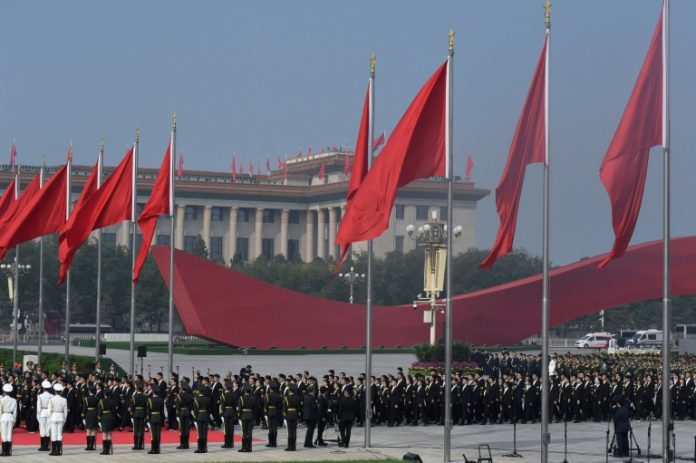Beijing put the finishing touches Monday to a massive military parade to celebrate Communist China’s 70th anniversary, but pro-democracy protesters in Hong Kong threatened to steal the global media spotlight.
Some 15,000 soldiers will march across Tiananmen Square and the latest military technology will be displayed on Tuesday in a patriotic show of strength to demonstrate the country’s emergence as a global superpower.
President Xi Jinping is expected to make a stirring speech ahead of the parade at the Gate of Heavenly Peace, the same spot where Chairman Mao Zedong announced the founding of the People’s Republic of China on October 1, 1949.
After the military march a civilian parade will involve 100,000 civilians and 70 floats, with organisers releasing 70,000 doves and 70,000 balloons before an evening performance and fireworks in Tiananmen.
The capital city was doused in red Chinese flags, flower displays, lanterns and political slogans ahead of the tightly-choreographed festivities.

The final seating stands were pulled into place in Tiananmen on Monday, with the whole square and central Beijing set to be closed off by evening.
Some roads were already closed on Sunday.
State broadcaster CCTV was playing patriotic shows throughout Monday and showing images of celebrating citizens, including ethnic minorities in traditional dress waving Chinese flags.
Xi paid tribute to Mao’s embalmed body at the late leader’s mausoleum at Tiananmen Square.
But the city’s pollution levels remained high – uncharacteristic ahead of a key event in China when authorities tend to close factories and produce clear skies.
While Beijing is preparing for huge celebrations, ongoing unrest in Hong Kong threatens to upstage festivities with authorities in the semi-autonomous city Monday warning of increased violence by “rioters”.
Tuesday’s protests will be “very, very dangerous” Superintendent John Tse said.
The southern city witnessed its fiercest political violence in weeks Sunday when riot police spent hours in running battles with protesters, the streets blanketed in tear gas and smoke from burning barricades.
Millions have hit the streets during nearly four months of pro-democracy protests, and hardcore activists have repeatedly clashed with police, in the biggest challenge to China’s rule since the city’s handover from Britain in 1997.

Democracy activists have dubbed it a “Day of Grief”, and there appears little sign of the protests abating in Hong Kong.
On Monday, authorities announced that they were upholding a ban on a planned National Day democracy march, citing security concerns.
The Civil Human Rights Front (CHRF), a group that advocates non-violence and was behind a series of huge peaceful rallies earlier in the summer, hit out at the decision, saying it was the fourth time their march proposals have been rejected.
“Hong Kong is now having less and less freedom and becoming more and more like Beijing,” CHRF spokeswoman Bonnie Leung told reporters.
With legal rallies banned, online forums used by the largely leaderless movement have instead called for wildcat protests across the city in an effort to stretch police resources.
School and university students also took part in a one-day class boycott on Monday.
The city’s summer of discontent was triggered by an extradition bill to the mainland that has now been shelved.
But the movement has since morphed into a call for free elections and less intervention from Beijing.
Protesters are calling for an independent inquiry into alleged police abuses, an amnesty for those arrested, and the right to elect their leaders – demands dismissed by China.
City leader Carrie Lam flew to Beijing Monday to take part in the National Day celebrations.












